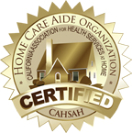Slips and falls in the home are a serious matter; they can result in major injuries (fractures of the hips and other bones) and medical complications. If long-term bed rest is needed after a fall, the person may develop pressure ulcers, joint problems, and pneumonia. The risk of falling increases with age (and is greater for women than for men); two-thirds of those who experience a fall will fall again within six months; and at least one-third of all falls in the elderly involve environmental hazards in the home.
The causes of falls are known as risk factors. The five key risk factors of falls among older adults include: osteoporosis; lack of physical activity; impaired vision; medications; and environmental hazards. Osteoporosis is a condition wherein bones become more porous, less resistant to stress, and more prone to fractures. Eat or drink sufficient calcium, get sufficient vitamin D to enhance the absorption of calcium, and regularly do weight-bearing exercises. Failure to exercise regularly results in poor muscle tone, decreased strength, and loss of bone mass and flexibility; these contribute to falls and the severity of injury due to falls. Engage regularly in exercises like walking and swimming, and wear proper fitting supportive shoes with low heels or rubber/nonskid soles. Cataracts and glaucoma alter older people’s depth perception, visual acuity, peripheral vision and susceptibility to glare, and these limitations hinder their ability to safely navigate their environment. Regular checkups by an opthalmologist, using color and contrast to define balance-aiding objects in the home, adding contrasting color strips to first and last steps to identify change of level, and cleaning eyeglasses often are preventive measures. Sedatives, anti-depressants, and anti-psychotic drugs can contribute to falls by reducing mental alertness, worsening balance and gait, and causing drops in systolic blood pressure while standing. Know the common side effects of all medications that you are taking, and talk with your physician or pharmacist about using the lowest effective dosage. If you drink, limit your intake of alcohol as it may interact with your medications. The most common hazard for falls is tripping over objects on the floor. Other factors include poor lighting, loose rugs, lack of grab bars or poorly located/mounted grab bars, electrical cords, raised doorway thresholds, slippery floors, clutter, and unsturdy furniture. Conduct a walk-through of your home to identify problems that may lead to falling. Consider having an occupational therapist do a walk-through of your residence; he or she is trained to identify risk factors or spot the hazards that our untrained eyes miss, and recommend appropriate actions.
Choose the right equipment for your needs. If you need a cane, walker or crutches, remember that the right shape, size and grip are vital. If you are in the market for a wheelchair or scooter, find one that fits you and your lifestyle. If possible, use several models on a trial basis before buying one. Having a seat-lift chair with electric-powered springs that gently move the chair up and down and tilt it forward helps a lot. Talk to your health care provider and visit a medical equipment store. Having the right equipment will help you move around more safely and independently.
Be proactive. And be prepared to handle a fall. Do you wear a medical alert tag or bracelet? Keep emergency numbers by the phone and set your phone up to include local numbers for the emergency medical services, police or sheriff, and fire department. Purchase a cordless phone so that you don’t have to rush to answer it. Make sure you and your family and friends know how to reach your health care provider, what drugs or foods you’re allergic to, and what medications you are taking. If you do fall, fall the “right way”. If possible, grab an object such as a nearby piece of furniture, or use your hands to help break your fall; keep your head up; relax your body as much as possible as this can help absorb the shock of the fall; and if you land feet first, bend your knees and curl your body as you touch the ground. To get up safely, roll onto your side; get onto your knees; put one foot flat on the ground; and stand up slowly. If you feel sharp pain or dizziness, lie still until medical help arrives.
A lack of knowledge about risk factors and how to prevent them contributes to many falls; the more risk factors to which you are exposed, the greater the probability of a fall and the more likely the results the next fall will threaten your independence (the most profound effect of falling). By maintaining an active, healthy lifestyle and making your home safe, you can still live life to the fullest.







